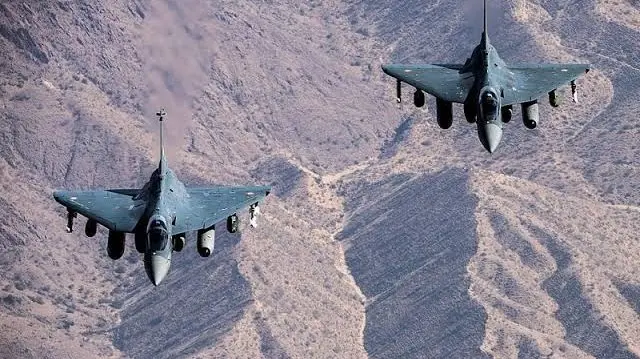
India inks ₹66,500 crore deal for 97 Tejas jets. A bold step toward defense self-reliance, air power upgrade, and strategic global positioning.
What India’s ₹66,500 Crore Tejas Jet Deal Means for Our Air Force
| By Rapid Updates Editorial Team
India’s Biggest Fighter Jet Deal Ever — What’s Happening Today?
Tejas Jet Deal – India is all set to sign its largest-ever fighter jet contract worth ₹66,500 crore. This deal is between the Ministry of Defence and Hindustan Aeronautics Limited (HAL), and it includes the purchase of 97 Tejas Mark-1A fighter jets. These jets are made in India and are part of the country’s push for self-reliance in defense, also known as “Atmanirbhar Bharat.”
The signing is expected to happen today, just one day before the Indian Air Force (IAF) retires 36 MiG-21 jets. These older jets have served the country for decades but are now outdated. With their retirement, the IAF will be left with only 29 fighter squadrons, which is much lower than the authorized strength of 42.5 squadrons. Each squadron usually has 16–18 aircraft.
This new deal is meant to fill that gap and strengthen India’s air power. It comes after a previous order in 2021 for 83 Tejas jets worth ₹46,898 crore, which are still awaiting delivery. HAL has promised to deliver the first two jets from that earlier order by October this year.
What Is the Tejas Jet and Why Is It So Important?
The Tejas Mark-1A is a fourth-generation, single-engine fighter jet designed for multiple roles-air defense, ground attack, and reconnaissance. It’s lightweight, fast, and equipped with modern avionics, radar systems, and weapons. It can carry missiles, bombs, and other payloads, making it a versatile tool for the IAF.
One of the biggest advantages of Tejas is that it’s made in India. This helps reduce dependence on foreign suppliers and boosts local industries. HAL manufactures these jets in Bengaluru and Nashik, and the company plans to increase production from 18 jets per year to 28 jets per year to meet demand.
The Tejas jets will be powered by GE-F404 engines supplied by General Electric. HAL has already received a few engines and expects to get 20 more each year. For the new 97-jet deal, HAL will sign another contract with GE for 113 more engines worth $1 billion.
The IAF has made it clear that it will only accept the jets after successful testing of weapons like Astra missiles, short-range air-to-air missiles, and laser-guided bombs. These tests are currently underway, and certification is expected soon.
Why This Deal Matters for India’s Security and Global Standing
This deal is not just about buying jets—it’s about preparing India for future challenges. Our neighbors, China and Pakistan, are rapidly upgrading their air forces. China has more than four times the number of fighter jets compared to India, and Pakistan is expected to receive 40 advanced J-35A stealth jets from China.
During Operation Sindoor, Pakistan used Chinese J-10 jets armed with long-range missiles. This raised alarms within the IAF, which conducted an internal review and concluded that India needs more than 42.5 squadrons to handle threats from both China and Pakistan.
The Tejas deal helps India close this gap. It also sends a strong message to the world that India is serious about modernizing its military and protecting its borders. By investing in indigenous technology, India is also building a defense ecosystem that can support future innovations.
This deal will create jobs, boost small and medium enterprises, and encourage more research and development in aerospace technology. It’s a win-win for national security and economic growth.
What Comes Next — Delivery, Deployment, and Long-Term Impact
Now that the deal is being signed, HAL will begin ramping up production. The first deliveries from the 2021 order are expected in October, and the new jets will follow in phases. HAL has already set up a third production line in Nashik to speed up manufacturing.
The IAF will start deploying these jets in squadrons across the country, replacing older aircraft and filling gaps in air defense. The retirement of MiG-21s marks the end of an era, and the arrival of Tejas jets marks the beginning of a new chapter.
The government is also planning to increase the indigenous content in Tejas jets to over 65%, which means more parts and systems will be made in India. This supports the “Make in India” initiative and reduces reliance on imports.
In the long run, this deal could lead to exports of Tejas jets to friendly countries. HAL has already received interest from nations in Southeast Asia, Africa, and Latin America. If successful, India could become a global supplier of fighter aircraft, boosting its strategic influence and economic power.
Final Thoughts
This ₹66,500 crore Tejas jet deal is more than just a defense contract—it’s a bold step toward a stronger, safer, and more self-reliant India. It reflects the country’s commitment to modernizing its military, supporting local industries, and preparing for future challenges. As the jets take flight, so does India’s ambition to lead in defense innovation and regional security.